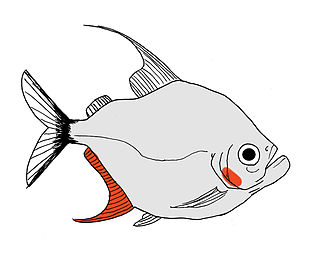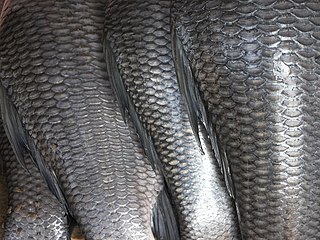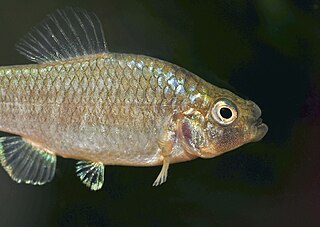
In evolutionary biology, adaptive radiation is a process in which organisms diversify rapidly from an ancestral species into a multitude of new forms, particularly when a change in the environment makes new resources available, alters biotic interactions or opens new environmental niches. Starting with a single ancestor, this process results in the speciation and phenotypic adaptation of an array of species exhibiting different morphological and physiological traits. The prototypical example of adaptive radiation is finch speciation on the Galapagos, but examples are known from around the world.

Cichlids are fish from the family Cichlidae in the order Cichliformes. Cichlids were traditionally classed in a suborder, the Labroidei, along with the wrasses (Labridae), in the order Perciformes, but molecular studies have contradicted this grouping. On the basis of fossil evidence, it first appeared in Tanzania during the Eocene epoch, about 46–45 million years ago. The closest living relative of cichlids is probably the convict blenny, and both families are classified in the 5th edition of Fishes of the World as the two families in the Cichliformes, part of the subseries Ovalentaria. This family is both large and diverse. At least 1,650 species have been scientifically described, making it one of the largest vertebrate families. New species are discovered annually, and many species remain undescribed. The actual number of species is therefore unknown, with estimates varying between 2,000 and 3,000.

Lake Tanganyika is an African Great Lake. It is the second-oldest freshwater lake in the world, the second-largest by volume, and the second-deepest, in all cases after Lake Baikal in Siberia. It is the world's longest freshwater lake. The lake is shared among four countries—Tanzania, the Democratic Republic of the Congo (DRC), Burundi, and Zambia, with Tanzania (46%) and DRC (40%) possessing the majority of the lake. It drains into the Congo River system and ultimately into the Atlantic Ocean.

Pupfish are a group of small killifish belonging to ten genera of the family Cyprinodontidae of ray-finned fish. Pupfish are especially noted for being found in extreme and isolated situations. They are primarily found in North America, South America, and the Caribbean region, but Aphanius species are from southwestern Asia, northern Africa, and southern Europe. As of August 2006, 120 nominal species and 9 subspecies were known. Several pupfish species are extinct and most extant species are listed. In the U.S., the most well-known pupfish species may be the Devil's Hole Desert Pupfish, native to Devil's Hole on the Nevada side of Death Valley National Park. Since 1995 the Devil's Hole Pupfish has been in a nearly steady decline, where it was close to extinction at 35–68 fish in 2013.

Variabilichromis moorii has no common name and is a species of freshwater cichlid endemic to Lake Tanganyika in eastern Africa. It is a small ovate bodied fish named for an early collector of fish from the lake, John Edmund Sharrock Moore (1870-1947) who was a cytologist, zoologist and led an expedition to Lake Tanganyika and who discovered this species. Juveniles are usually yellow, and adults are dark brown to black in color. It reaches a total length (TL) of 10.3 centimetres (4.1 in). Currently it is the only member of its genus. V. moorii feeds on algae, zooplankton, and benthic invertebrates. It is also found in the aquarium trade.

Cyprinodon is a genus of pupfishes found in waters that range from fresh to hypersaline. The genus is primarily found in Mexico, the Caribbean Islands and southern United States, but C. variegatus occurs as far north as Massachusetts and along the entire Gulf of Mexico coastline, and C. dearborni and C. variegatus are found in northern South America. Many species have tiny ranges and are highly threatened, in some cases already extinct. Cyprinodon are small; the largest reaches 10 cm (3.9 in) in length and most other species only reach about half that size.

Paedophagy in its general form is the feeding behaviour of fish or other animals whose diet is partially, or primarily the eggs or larvae of other animals. However, P. H. Greenwood, who was the first to describe paedophagia, defines it to be a feeding behaviour evolved among cichlid fishes.

The wimple piranha, Catoprion mento, is a specialized, South American species of piranha that feeds on fish scales. There is debates over whether or not this species is considered a true piranha. If it was considered a true piranha, then it would be the smallest species in the world

Catoprion is a genus of serrasalmids from tropical South America, including the basins of the Amazon, Essequibo, Orinoco and Paraguay rivers. It was believed to be a monotypic genus until the 2020 description of C. absconditus.
The Maya pupfish, known in Spanish as cachorrito gigante, is a highly threatened species of fish in the family Cyprinodontidae. It is endemic to Lake Chichancanab in Quintana Roo, Mexico. In almost all places, different Cyprinodon species do not overlap in their range, but there are two notable exceptions and one of these is Lake Chichancanab, which is inhabited by C. maya, C. beltrani, C. esconditus, C. labiosus, C. simus, C. suavium and C. verecundus. Living together, the Cyprinodon species in Lake Chichancanab have diverged into different niches. Pupfish typically feed on algae and detritus. In Lake Chichancanab, however, C. maya has become not only the largest species in the genus Cyprinodon, up to 10 cm (3.9 in) long, but also the only that catches and eats whole fish. In smaller quantities it eats ostracods and freshwater snails.
The largefin pupfish, also known as cachorrito de dorsal larga, is a small species of pupfish in the family Cyprinodontidae. It is endemic to Lake Chichancanab in Quintana Roo, Mexico. In almost all places, different Cyprinodon species do not overlap in their range, but there are two notable exceptions and one of these is Lake Chichancanab, which is inhabited by C. verecundus, C. beltrani, C. esconditus, C. labiosus, C. maya, C. simus and C. suavium. Living together, the Cyprinodon species in Lake Chichancanab have diverged into different niches. Pupfish typically feed on algae and detritus. In Lake Chichancanab, however, C. verecundus has become an amphipod- and bivalve-eater.

Perissodus microlepis is a species of cichlid endemic to Lake Tanganyika. This species reaches a length of 11 centimetres (4.3 in) TL. This species can also be found in the aquarium trade. It is a scale-eating 'parasite' on other fish species. It occurs in two distinct morphological forms. One morph has mouth parts twisted to the left, enabling it to eat scales off its victim's right flank. In contrast, the other morph, whose mouth is twisted to the right, eats scales off its victim's left flank. The relative abundance of the two morphs in populations is regulated by frequency-dependent selection.
Plecodus elaviae is a species of cichlid endemic to Lake Tanganyika. This schooling species is a scale-eater, plucking scales from other fishes. Both parents care for the offspring in this mouthbrooder. This fish can reach a length of 32 centimetres (13 in) TL.

Plecodus is a genus of cichlids endemic to Lake Tanganyika in Africa. They feed on scales.

Plecodus paradoxus is a species of cichlid endemic to Lake Tanganyika. This fish is a scale-eater, gathering in large schools exceeding 500 individuals and eating the scales of other fish. This species can reach a length of 30 centimetres (12 in) TL.
Plecodus straeleni is a species of cichlid fish that is endemic to Lake Tanganyika in East Africa. This species can reach a total length of 16 centimetres (6.3 in).

A fish scale is a small rigid plate that grows out of the skin of a fish. The skin of most jawed fishes is covered with these protective scales, which can also provide effective camouflage through the use of reflection and colouration, as well as possible hydrodynamic advantages. The term scale derives from the Old French escale, meaning a shell pod or husk.

Cyprinodon desquamator is a scale-eating species of pupfish in the genus Cyprinodon. It is endemic to hypersaline interior lakes on San Salvador Island, Bahamas. It coexists alongside two other closely related Cyprinodon species C. brontotheroides and C. variegatus. Together, these three species represent a recent adaptive radiation, each having moved into a difference niche within their specialized environment. Each of these species are defined by distinct trophic adaptations that have affected various aspects of their functional morphology, behavior, strike kinematics, and reproductive coloration.

Cyprinodon brontotheroides is a species of pupfish in the genus Cyprinodon.















